Oxford United
Headington United, an amateur village side founded in 1893, competed in local leagues until they joined the amateur Spartan League wearing dark blue and orange. Their original name was simply Headington, the United suffix being added in 1894. They led a nomadic existence until 1926, when they moved into the Manor Ground, which would be their home until 2001.
After the Second World War the club adopted a more ambitious attitude. They joined the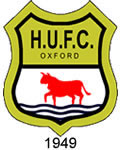 Southern League in 1949, turned professional and adopted gold and black. A year later they installed floodlights, long before most Football League clubs, and in 1953, t
Southern League in 1949, turned professional and adopted gold and black. A year later they installed floodlights, long before most Football League clubs, and in 1953, t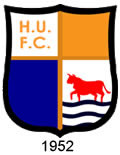 hey won the Southern League title. In 1954 they reached the FA Cup fourth round proper, disposing of Millwall and Stockport County before losing to Bolton Wanderers, then in the First Division. With their sights set firmly on joining the Football League, Headington invested heavily in ground improvements.
hey won the Southern League title. In 1954 they reached the FA Cup fourth round proper, disposing of Millwall and Stockport County before losing to Bolton Wanderers, then in the First Division. With their sights set firmly on joining the Football League, Headington invested heavily in ground improvements.
Two crests appeared in this period, both of which featured a visual pun on the word Oxford.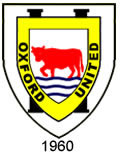
The appointment of former Birmingham City manager, Arthur Turner in 1959 proved to be the key to success. In 1960, in an effort to gain wider recognition, Headington became Oxford United and went on to win two more Southern League championships. A competition was organised to create a new crest for the renamed club, which was one by a Mr SEV Clarke, whose design included a partially concealed letter "H" as a reminder of their original name. This crest did not appear on the team shirts.
In March 1962, Accrington Stanley resigned from the League. With only the last three Fourth Division clubs required to apply for re-election, there was a guaranteed place for a non-league side available when the League AGM convened in June. No fewer than 26 clubs applied: Oxford were overwhelmingly elected with 39 votes, 24 votes ahead of their nearest rivals who got a mere 5 votes.
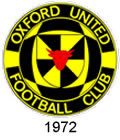 After two years consolidating in Division Four, United were promoted and in 1968 they won the Third Division title.
After two years consolidating in Division Four, United were promoted and in 1968 they won the Third Division title.
In 1972 a new crest was introduced and this version was worn on the shirts from 1973. This design appeared in various combinations until it was dropped in 1980.
After eight seasons in Division Two United, now wearing blue and gold once again, were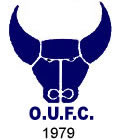 relegated in 1976.
relegated in 1976.
In 1979 the zoologist and author of popular science books, Desmond Morris, who was also a former director of the club, was asked to design a new crest. He came up with a stylised ox head, a design that was distinctive and easily recognisable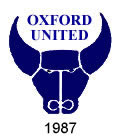 from a distance. The original version had the club's initials embroidered underneath but from 1987 these were replaced by the club's name in full placed between the horns. Several variations of both versions appeared that featured commemorative wording embroidered around or below the badge.
from a distance. The original version had the club's initials embroidered underneath but from 1987 these were replaced by the club's name in full placed between the horns. Several variations of both versions appeared that featured commemorative wording embroidered around or below the badge.
After five years languishing in the lower reaches of the Third Division and with financial problems crippling the club, millionaire publisher, Robert Maxwell bought Oxford United in January 1982 and saved them from bankruptcy. Under Maxwell's ownership, the teams wore a variety of sponsorship logos representing the various companies that were part of his publishing empire.
Two consecutive championships in 1984 and 1985 took Oxford into the First Division for the first time in their history. For three seasons, Oxford managed to stave off relegation and in the process, they won the League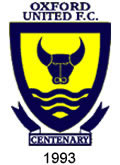 Cup in April 1986. Meanwhile, Maxwell was floating the idea of merging United with Reading FC to form a new club to be known as Thames Valley Royals. Naturally the proposals met with hostility from both sets of supporters and were eventually dropped. In 1991 Maxwell was lost at sea, presumed to have fallen from his yacht and drowned. Without his money, United were forced to sell off players and trim their costs. Inevitably t
Cup in April 1986. Meanwhile, Maxwell was floating the idea of merging United with Reading FC to form a new club to be known as Thames Valley Royals. Naturally the proposals met with hostility from both sets of supporters and were eventually dropped. In 1991 Maxwell was lost at sea, presumed to have fallen from his yacht and drowned. Without his money, United were forced to sell off players and trim their costs. Inevitably t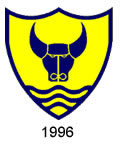 hey dropped into what was now called Division Two (the old Third Division) in 1994, at the end of their centenary season (during which a special crest was worn).
hey dropped into what was now called Division Two (the old Third Division) in 1994, at the end of their centenary season (during which a special crest was worn).
In 1995-96 the club was granted permission to build a new stadium to the south of Oxford and they won promotion. The crest was redesigned, based on a simplified version of the centenary crest.
Financial problems, exacerbated by the rising costs of the new stadium, led to the club going into administration. A takeover and the sale of the Manor Ground for redevelopment saved the stricken club but the cost was consecutive relegations in 1999 and 2001,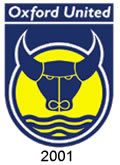 which left them in League Two, the lowest tier of the Football League.
which left them in League Two, the lowest tier of the Football League.
In 2001 they moved into the Kassam Stadium (named after Firoz Kassam, who had bought the club for £1 and saved them from bankruptcy). Due to the club's reduced circumstances, only three sides of the ground were completed: the building of a fourth stand was postponed until the club's fortunes revive. The crest was once again redesigned to coincide with the move to their new home.
Disaster struck in 2006 when they were relegated to the Conference on the last day of the season. By a cruel irony, one of the clubs promoted was the revived Accrington Stanley, whom United had replaced in 1962. Their stay in the Conference lasted just four seasons before they regained their place in the Football League via the play-offs.
